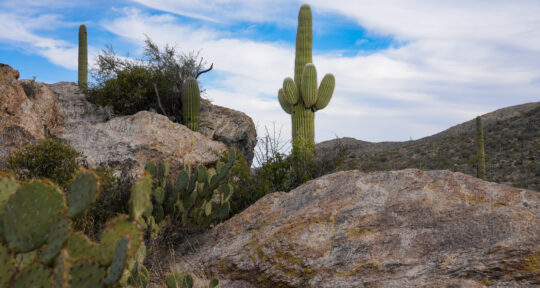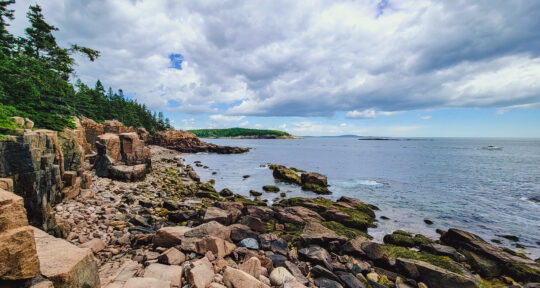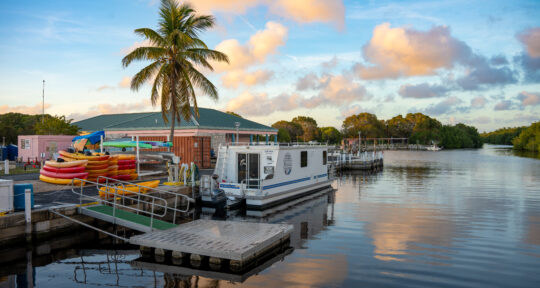Before setting off on a three-year, 75,000-mile journey, Mikah Meyer says he was a “naive Pollyanna.” Despite being green, this April, the 33-year-old will become the first person to visit all the national park sites in the United States—including those in Alaska, Hawaii, and the U.S. territories—in one continuous journey.
“Sometimes we have to be a little naive, because if we know the reality, we won’t take on crazy projects,” Meyer says. When he began planning for his project five years ago, there were 406 national park sites. Now there are 419.
Meyer set off on his journey in 2016 to honor his late father. When his father, a pastor in Nebraska, passed away at age 58, Meyer was only 19, and the loss left him with a profound life lesson: “Whatever dream you have, do it sooner than later.”
It was both spiritual and poetic for Meyer that the year he set off on his journey, he was turning 30—and the National Park Service was turning 100. Turning 30, Meyer says, is “a momentous year when society looks at us and says, ‘okay, you have to have everything figured out.’ It was a sign.”
Chasing sponsorships
After two years of planning, Meyer’s trek began on April 29, 2016 at the Washington Monument in D.C. It will end at the Lincoln Memorial, exactly three years to the minute of his journey’s start—on the anniversary of his father’s passing.
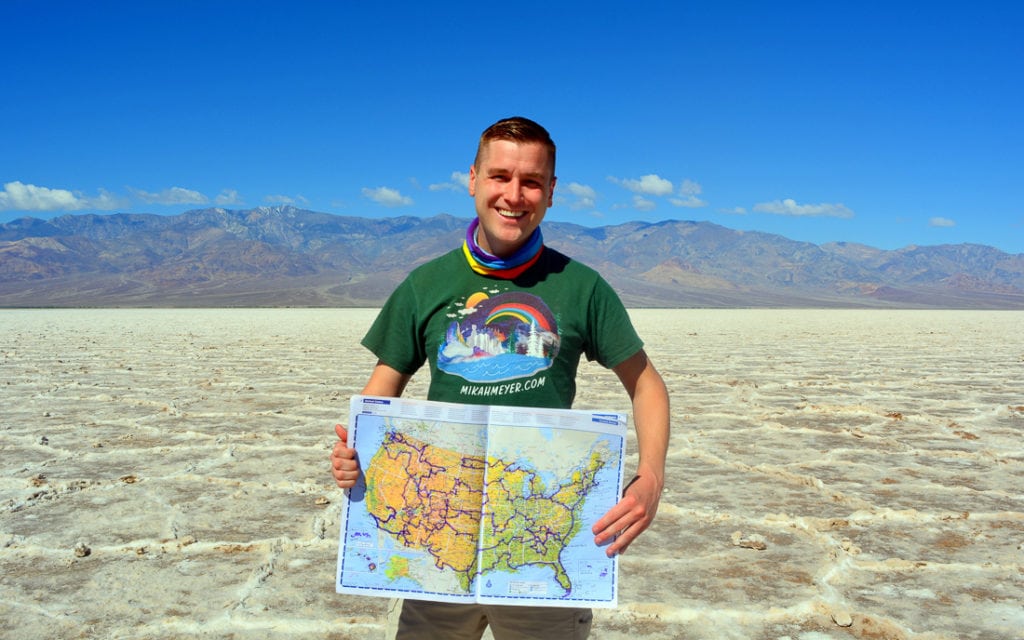
As part of his two-year planning process, Meyer reached out to more than 500 companies for sponsorships, but began his road trip without funding or wheels. Many liked his story, but with zero social media presence, Meyer says, no one was interested. Three years later, his Instagram account has 72,000 followers.
Meyer’s van is another example of what he calls “my Pollyanna gone wrong.” He was convinced that a company would seize on his journey and provide him with transportation. A year before he left, he walked around an RV show with one-pagers, telling companies, “Your RV will be seen in every park site in America.” It wasn’t until March, one month before the launch of his journey, that he finally realized, “Nobody cares, I have to buy a van, and quick.”
Despite not having wheels, Meyer had mapped out his route. “I was researching weather patterns and where to be during different seasons so that I could live in my van without heating or air conditioning and always be somewhere where it was temperate.” Plus, not all national parks are open year round.
Last-minute van build
Just weeks before his launch date, Meyer bought a totally bare, 2014 Ram Promaster cargo van for $25,000 on Craigslist. He still owes the seller $5,000. “It went from nothing to a little home on wheels,” says Meyer, who named his home “Vanny McVanface” (after the British naming “scandal” of 2016 that left a scientific research vessel christened Boaty McBoatface).
Vanny’s construction was a rushed project that wasn’t complete until Meyer was two months into his adventure. He stayed in the D.C. area and visited local park sites (there are 34 in D.C.) while he built the van, calling it “the most stressful two months of my life.”
Give yourself a year, minimum, Meyer recommends, to design and build a living situation. He prepped the van by laying down the insulation. Then an architect in Virginia donated his time, putting in flooring, walls, desk, a refrigerator, and a queen bed with more than 100 cubic feet of storage underneath (for everything from swim trunks to parkas). Even at 6-foot-1, Meyer was able to stand in the van.
And then, feeling green and ambitious, rather than using propane tanks, Meyer installed solar panels to run the fridge. “I have never been more terrified than when drilling into a $30,000-manufacturers-suggested-retail-price van to install five solar panels,” Meyer recalls. That’s in addition to an accompanying inverter and 250 pounds of batteries. He says the concept was born out of “the apex of cheapness,” and it also made sense environmentally. “How could I be going to all the parks and trying to be as green as possible while throwing out propane tanks everywhere and replacing them?” he says.
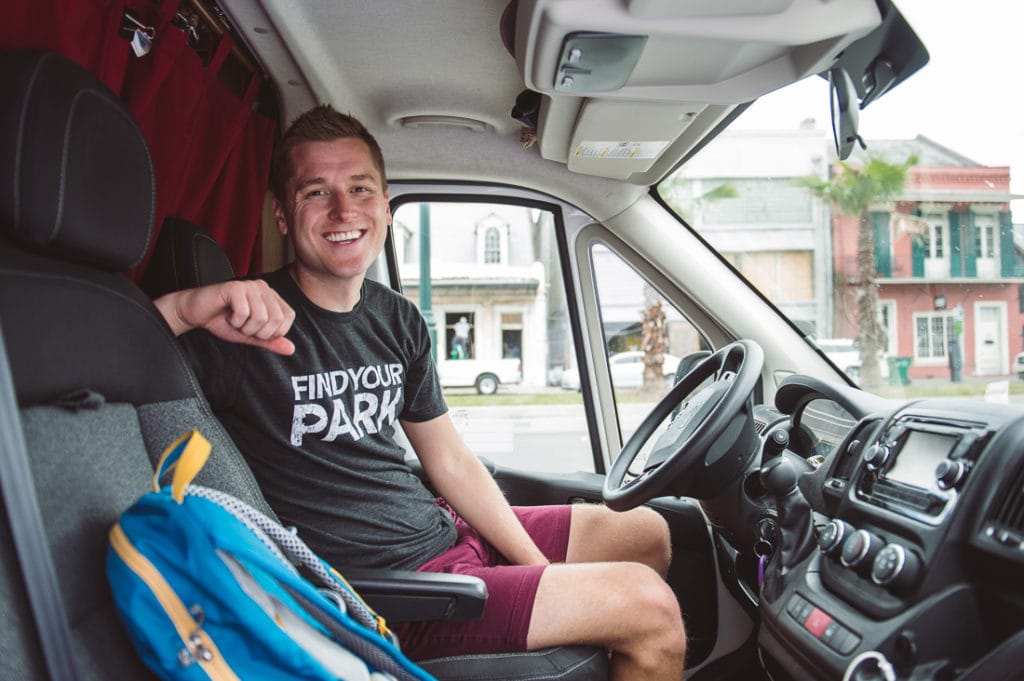
Living and eating in the van has saved Meyer thousands of dollars over the course of three years. “Every single meal was out of my fridge. Breakfast of yogurt. Lunch was a sandwich or a salad. Then, I started needing WiFi at night.” So for dinner, Meyer would find a restaurant where he used the WiFi until closing. “That sort of became my norm. As soon as the restaurant closed, I’d climb into the van, find a local hotel parking lot, pull in, climb over, and go to bed.”
Meyer also slept in store parking lots and on side streets. “Only once during my trip did someone knock on the door of the van, and that was in a Walmart parking lot in Albuquerque,” he says. “Which was weird, because there were a lot of RVs parked in the parking lot.” With some exceptions, Walmart allows for overnight parking. That knock was a wakeup call, suggesting he leave the lot by 5 a.m.
With a membership at a national gym chain, Meyer has been showering at workout facility locations all over the country. His driving has averaged 68 miles per day, though there were long days, too. In Alaska, he drove from sunrise until sunset, which is 8 a.m. to midnight during the summer.
Keeping the van in prime condition
Alone on the road, Meyer felt a constant, daily worry about whether the van would hold up. And some days were even more stress-inducing, such as the first time he drove in Boston. “I didn’t know if the van’s solar panels would fit under the highway underpass,” he says. He found out later that he had an eight-inch clearance. “In South Texas, my solar panel thing fried and for about a month I slept with my fire extinguisher by my side because I thought, if something sparks, I’m going to burn to death.”
He’s had only one car emergency during his three-year journey, an “oil sensor blow-up” which forced him on a nerve-wracking one-hour drive from Topeka to Kansas City. “Fortunately, it happened after I went to the Brown vs. Board of Education National Historic Site that morning, and they were able to fix it that afternoon. And, I still got to my tour of the Harry S. Truman Historic Site the next afternoon.”
Keeping the van in prime driving condition cost Meyer up to $5,000 a year. He checked the oil himself and took the vehicle in for oil changes every 5,000 miles. There was one new set of tires and windshield wipers.
And, at times, there was more stress than joy. “For the first time in my life, I wasn’t at a church every Sunday. I was spiritually drained, I was physically drained, and I was financially drained.” Other than a few personal donations (and a few small sponsorships—including all fill-ups at Flying J and Pilot), by January, 2017, Meyer was almost out of money. Overwhelmed, he thought about quitting his history-making trek.
And that’s when he started “singing for his supper.”
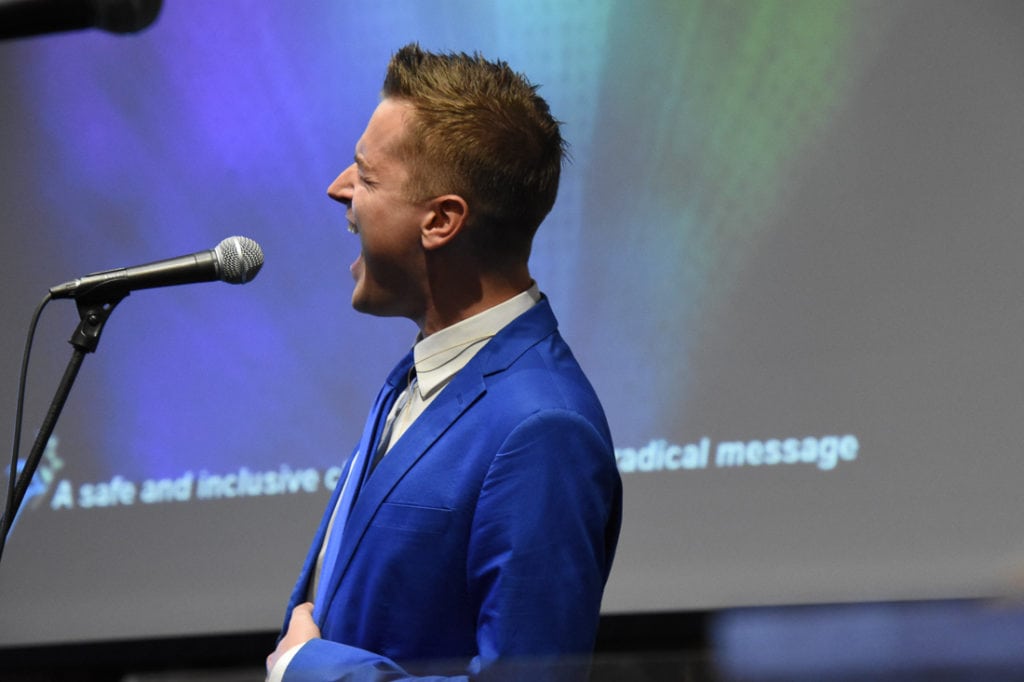
A revelatory experience
A pastor friend in Ft. Lauderdale, Florida told Meyer he could sing at his church’s Sunday service. At the last minute, Meyer says the pastor told him he’d be preaching the sermon, too. “‘Just go out there and tell them about your parks journey and growing up gay in the church and tie it into the gospel somehow,’ he told me,” Meyer says.
Meyer had come out eight years before his journey. But his search for sponsors had left him hesitating. “I found myself going into self-preservation mode,” Meyer recalls. “So I took any opportunity I had to lower my voice and keep it all about the parks, my dad, and anything that wouldn’t offend anyone, to keep this dream alive.”
But the church experience was revelatory.
Many people talked with him about relatives who were LBGT. “One gentleman said to me, ‘I’m gay and I never thought I’d hear those words and my story from the pulpit.’” Donations from the Ft. Lauderdale church were enough to get Meyer to the next park—and the pastor recommended Meyer to another pastor who recommended him to another pastor, and so on. Over time, Meyer’s original sermon transformed into a “National Parks Cabaret.” Through 150 performances at locations throughout the country, he got the funding he needed to finish his journey.
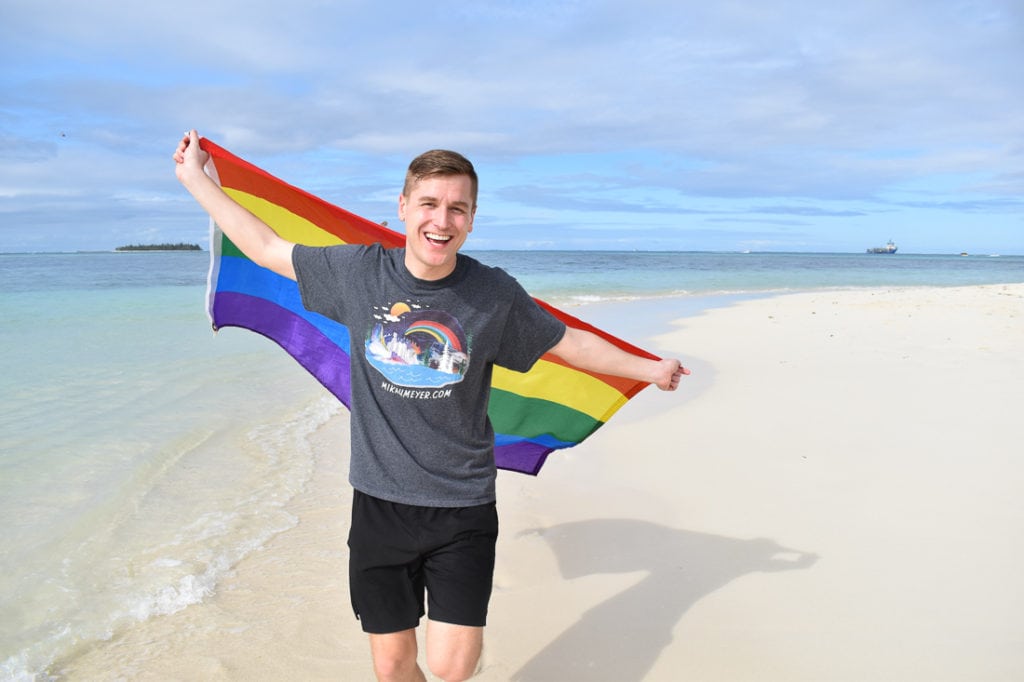
And, the church experience brought Meyer to a crossroads. He went from asking himself, “How can I hide being gay?” to “How can I celebrate this and share this?” Meyer began taking pictures with the rainbow flag, calling it “a quick visual confirmation of what I had been trying to keep hidden.”
But, his professional coming-out cost him a long-term sponsorship. “I was told I was ‘done,’ because I was doing too much LGBT advocacy.” The jolt sparked in him a new mission, and in October, 2018, he struck a deal with REI. Meyer says he became the first openly gay man to be featured in an outdoors recreation campaign.
Meyer wants to continue finding the kind of joy he discovered on this journey, he says, “using travel to reach people who may not be able to be reached in any other way, to break stereotypes, and to encourage people to live life fully.” He gets several messages a day from people who tell him how his journey as an openly gay role model has positively impacted them.
His next journey will bring him home to Nebraska where he plans to follow the Nebraska State football team to every game. “It’s the envy of every husker—and something that most people wouldn’t think a gay man would enjoy doing.”
Mikah Meyer’s best road trips tips
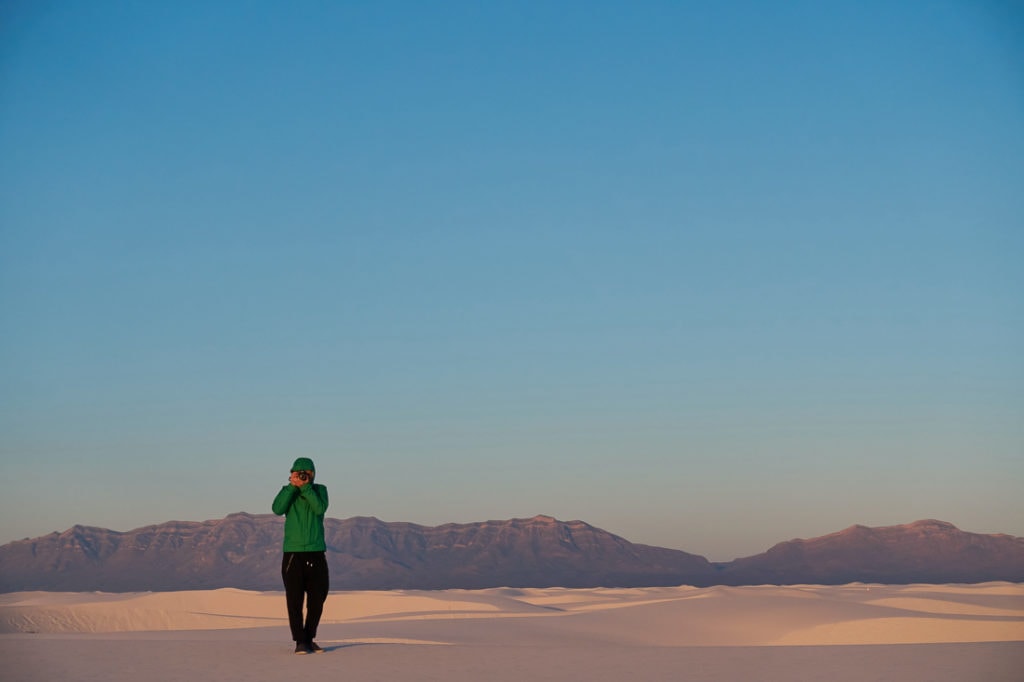
Plan time for the unexpected
“Whether something goes wrong or something goes right, you are going to want a time buffer to spend an extra day at a place you really like or to move forward if you didn’t like the place as much as you thought you would. Or to do your laundry…”
Plan for real life
“I can’t tell you how many days I had to stop because some sort of ‘normal’ life situation came up that needed to be dealt with.” And, despite the digital age, Meyer says having a street address remains a necessary evil. He has friends and family handle his mail.
Pick the people over the place
“It doesn’t really matter where you go, but it does matter who you go with and who you meet there.” As a solo traveler, “The tough thing was being out in these stunning natural landscapes and wanting to share them with someone.”
Know before you go
“I wish I would have known what pulling off a trip of this nature would take. I wish I had prepared better for it mentally. I think I sort of imagined it would be like all the other road trips I took in the past. I went into it thinking it was a pleasure cruise. It was way harder than I thought.”
Make goals you can control
“The goal became a double-edged sword. It’s great because I have this checklist that’s keeping me motivated. [But] it’s terrifying because it’s locked me into a list someone else created.”
If you build a house on wheels, make sure to include the following:
Accessible storage, a non-bed place to relax, running water, a bathroom, and a way to cook inside the van.
Roadtrippers last talked to Mikah Meyer 11 months ago, when he gave us the lowdown on national parks.

